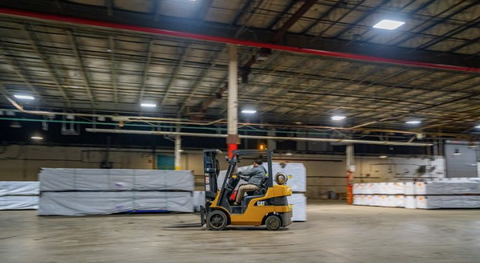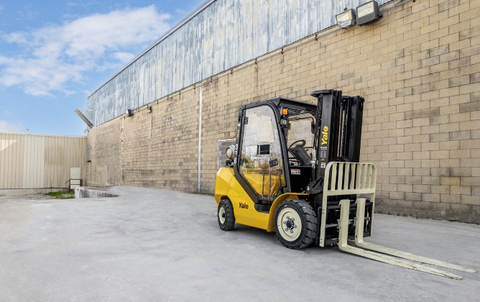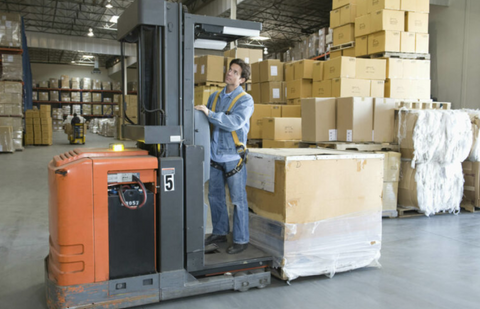
When it comes to moving heavy loads in warehouses, distribution centers, and manufacturing facilities, forklifts are an indispensable tool.
They come in various shapes and sizes, each designed for specific tasks and environments. Among the most common types are sit-down and stand-up forklifts, each offering unique advantages depending on the job at hand.
In this article, we'll dive into the differences between these two types of forklifts, helping you make an informed decision about which one suits your needs best.
Sit-Down Forklifts: The Workhorse of the Warehouse
Sit-down forklifts, also known as counterbalance forklifts, are the traditional choice for many operations.
These forklifts feature a seat for the operator to sit on while driving, controlling the vehicle's functions with pedals, and a steering wheel. They typically come in electric, gas, or diesel-powered variations, providing flexibility to suit different working environments.

Sit-down forklifts typically have a lower center of gravity due to the counterbalance weight at the rear, providing added stability when lifting and transporting heavy loads. Photo by: ProEnclosures
Advantages of Sit-Down Forklifts:
Comfort and Ergonomics—One of the primary benefits of sit-down forklifts is the comfort they provide to operators. With a padded seat and ample legroom, operators can comfortably navigate the warehouse for extended periods without experiencing fatigue.
Stability—Sit-down forklifts are designed with a counterbalance weight at the rear of the vehicle, which helps stabilize heavy loads during lifting and maneuvering. This design feature enhances safety and reduces the risk of tipping, especially when handling bulky or unevenly shaped loads.
Versatility—Sit-down forklifts are versatile machines suitable for a wide range of applications. Whether you're stacking pallets in narrow aisles or loading/unloading trucks in a busy dockyard.
Operator Familiarity—Many operators are trained and experienced in using sit-down forklifts, making them a familiar and preferred choice in many workplaces. This familiarity can lead to increased efficiency and productivity as operators require less time to adapt to the vehicle's controls.
Stand-Up Forklifts: Maneuverability and Efficiency Combined
Stand-up forklifts, also known as reach trucks, offer a different approach to material handling compared to their sit-down counterparts.
Instead of sitting, operators stand on a platform while driving and maneuvering the vehicle. These forklifts are designed for efficiency in high-density storage environments, where maneuverability and tight turning radius are crucial.

Stand-up forklifts often feature extendable mast systems, enabling operators to reach greater heights when stacking or retrieving pallets from elevated storage racks. Photo by: SafeOpedia
Advantages of Stand-Up Forklifts:
Compact Design—Stand-up forklifts are known for their compact design, making them ideal for navigating narrow aisles and confined spaces within warehouses. The stand-up configuration eliminates the need for a large seating area, allowing for tighter turns and improved maneuverability.
Visibility—Standing on a platform provides operators with enhanced visibility of their surroundings, including the load being carried and the pathway ahead. This improved visibility reduces the risk of accidents and collisions, especially in busy warehouse environments where pedestrian traffic is common.
Quick Directional Changes—Stand-up forklifts excel at making quick directional changes, thanks to their agile nature and responsive controls. Operators can easily navigate tight corners and maneuver through narrow aisles without sacrificing speed or efficiency.
Increased Reach—As the name suggests, stand-up forklifts often feature extendable mast systems that allow for greater vertical reach when stacking or retrieving pallets from elevated storage racks. This capability is particularly advantageous in warehouses with high shelving systems where space optimization is essential.
Choosing the Right Forklift for Your Needs
Deciding between a sit-down and stand-up forklift depends on various factors, including your specific operational requirements, the layout of your facility, and the type of loads you handle regularly. Here are some considerations to help you make an informed decision:
Space Constraints—If your warehouse or distribution center has narrow aisles and limited space for maneuvering, a stand-up forklift may be the better choice due to its compact design and agility.
Load Characteristics—Consider the size, weight, and shape of the loads you typically handle. Sit-down forklifts are well-suited for heavy and bulky loads that require stability, while stand-up forklifts are ideal for maneuvering lighter loads in confined spaces.
Operator Preference and Training—Take into account the preferences and skill levels of your operators. Some may feel more comfortable and confident operating a sit-down forklift, while others may prefer the agility and visibility offered by a stand-up model.
Cost and Maintenance—Compare the upfront costs and ongoing maintenance requirements of both sit-down and stand-up forklifts. Consider factors such as fuel efficiency, battery life (for electric models), and the availability of replacement parts when evaluating the long-term cost of ownership.
Sit-Down vs. Stand-Up Forklift
Sit-down and stand-up forklifts each offer unique advantages depending on the specific needs and challenges of your operation.
While sit-down forklifts excel in stability and versatility, stand-up forklifts are unmatched in maneuverability and efficiency in confined spaces.
By carefully evaluating your requirements and considering the factors outlined in this article, you can choose the right forklift to enhance productivity and safety in your workplace.
Whether you opt for the tried-and-tested sit-down model or the agile stand-up variation, investing in the right forklift can streamline your material handling processes and contribute to the overall success of your business.
Looking for forklift accessories? Check our roofs, doors, windshields, and more.





Leave a comment